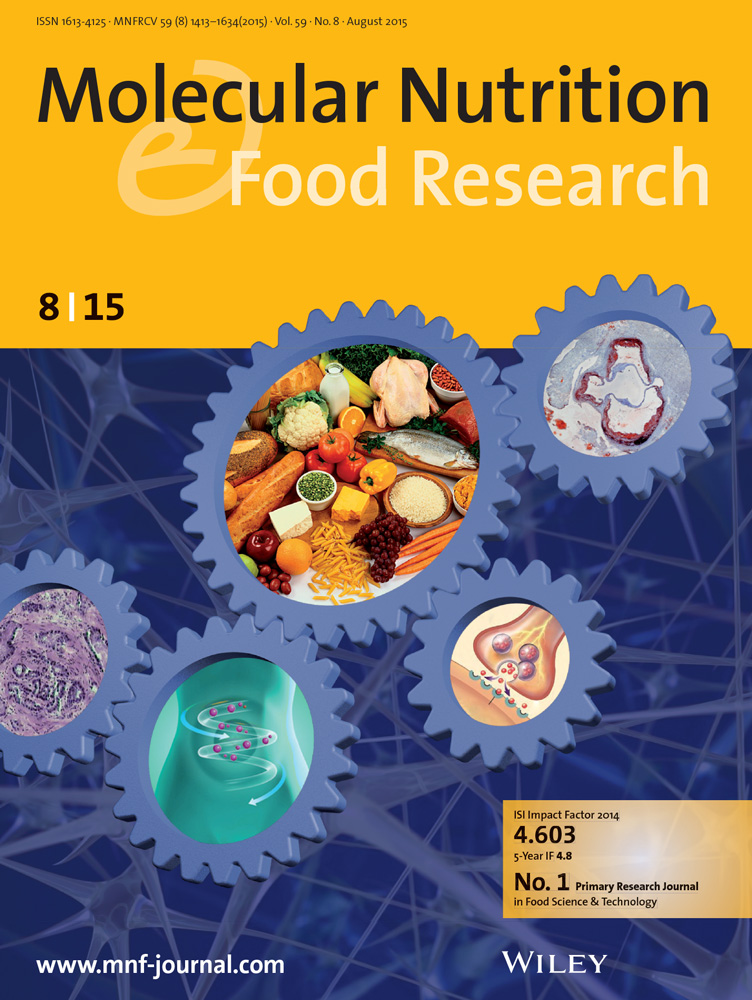Protective Role of the Natural Antioxidant Astaxanthin in Both Human Bronchial Epithelial Cells (BEAS-2B) and Non-Small Cell Lung Cancer Cells (H1975) Exposed to Cadmium: Impact on the Generation of Reactive Oxygen Species and Cancer Cell Migration.
IF 4.2
2区 农林科学
Q1 FOOD SCIENCE & TECHNOLOGY
引用次数: 0
Abstract
Cadmium (Cd) is a heavy metal and human carcinogen that displays toxicity to many organ systems. This work addresses the impact of Cd, alone or combined with astaxanthin (ATX), in human non-small cell lung cancer (NSCLC) cells (H1975) and nonmalignant bronchial epithelial cells (BEAS-2B). The endpoints selected comprise cell viability, migration, generation of reactive oxygen species (ROS), and a metabolomic study. Cd (up to 140 µM) was evaluated with the crystal violet (CV) and MTS assays and revealed cytotoxicity at high concentrations, with greater extent in nonmalignant cells. ATX (up to 20 µM) revealed no cytotoxicity. Cd increased ROS generation (dichlorodihydro-fluorescein diacetate fluorometric assay) in a concentration-dependent manner for both cell lines, with this effect being reverted by ATX. Cd at noncytotoxic concentrations (up to 10 µM) increased collective cell migration, with this pro-migratory effect being mitigated upon ATX co-treatment. The metabolome analysis yielded no significant metabolic alterations in the endo- or exometabolome. Overall, Cd exhibits cytotoxicity in lung cells, with differential sensitivity between nonmalignant and malignant cells. Importantly, Cd promotes NSCLC cell migration and ROS production in lung cells, which can be ameliorated by ATX, reinforcing the protective properties of this dietary carotenoid against toxic exposures.天然抗氧化剂虾青素对暴露于镉的人支气管上皮细胞(BEAS-2B)和非小细胞肺癌细胞(H1975)的保护作用:对活性氧产生和癌细胞迁移的影响
镉(Cd)是一种重金属和人类致癌物,对许多器官系统显示毒性。这项工作研究了Cd单独或联合虾青素(ATX)对人类非小细胞肺癌(NSCLC)细胞(H1975)和非恶性支气管上皮细胞(BEAS-2B)的影响。选择的终点包括细胞活力、迁移、活性氧(ROS)的产生和代谢组学研究。用结晶紫(CV)和MTS试验评估Cd(高达140µM),发现高浓度的细胞毒性,对非恶性细胞的毒性更大。ATX(高达20µM)显示无细胞毒性。Cd以浓度依赖的方式增加了两种细胞系的ROS生成(二氯二氢荧光素二醋酸酯荧光测定法),这种效应被ATX逆转。非细胞毒性浓度(高达10 μ M)的Cd增加了细胞的集体迁移,这种促进迁移的作用在ATX共处理后被减轻。代谢组分析显示,内代谢组和外代谢组没有显著的代谢改变。总的来说,Cd在肺细胞中表现出细胞毒性,在非恶性和恶性细胞之间具有不同的敏感性。重要的是,Cd促进了非小细胞肺癌细胞的迁移和肺细胞中ROS的产生,这可以通过ATX改善,增强了这种膳食类胡萝卜素对毒性暴露的保护特性。
本文章由计算机程序翻译,如有差异,请以英文原文为准。
求助全文
约1分钟内获得全文
求助全文
来源期刊

Molecular Nutrition & Food Research
工程技术-食品科技
CiteScore
8.70
自引率
1.90%
发文量
250
审稿时长
1.7 months
期刊介绍:
Molecular Nutrition & Food Research is a primary research journal devoted to health, safety and all aspects of molecular nutrition such as nutritional biochemistry, nutrigenomics and metabolomics aiming to link the information arising from related disciplines:
Bioactivity: Nutritional and medical effects of food constituents including bioavailability and kinetics.
Immunology: Understanding the interactions of food and the immune system.
Microbiology: Food spoilage, food pathogens, chemical and physical approaches of fermented foods and novel microbial processes.
Chemistry: Isolation and analysis of bioactive food ingredients while considering environmental aspects.
 求助内容:
求助内容: 应助结果提醒方式:
应助结果提醒方式:


